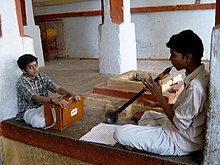Shruti box
This article needs additional citations for verification. (December 2011) |




A shruti box (sruti box, shrutibox, srutibox or surpeti) is a
Adjustable buttons allow tuning. Nowadays,
Recent versions also allow for changes to be made in the tempo, and the notes such as Madhyamam, Nishadam to be played in place of the usual three notes (i.e., Lower shadjam, panchamam, and the upper shadjam).History
Before the arrival of the
Later, a keyless version of the harmonium was invented for the specific purpose of producing the drone sound. It was given the name shruti box or sruti box. These types of instruments had controls on the top or on the side of the box for controlling the pitch.[citation needed]
The shruti box is enjoying a renaissance in the West among traditional and contemporary musicians, who are using it for a range of different styles. In the early nineties, traditional Irish singer Nóirín Ní Riain brought the shruti box to Ireland, giving it a minor place in traditional Irish music. More recently Scottish folk artists Karine Polwart and Julie Fowlis used the instrument on some of their songs.[4][5] Singers find it very useful as an accompaniment and instrumentalists enjoy the drone reference it gives to play along with.[citation needed]
See also
References
- Hinduism Today. Retrieved 6 December 2011.
- ISBN 9780756676384.
- ^ Montes, Manuel. "Nóirín Ní Riain: Celtic Soul". Amazing Sounds. Retrieved 6 December 2011.
- ^ "Karine Polwart FAQs". karinepolwart.com. Retrieved 6 December 2011.
- ^ A Ghaoil, Leig Dhachaigh Gum Mhathair Mi, by Julie Fowlis, from the album 'Gach Sgeul / Every Story', on youtube.com
External links
- Pocket Shruti Box (Android app) produces Tambura drone based on a physical model developed by researchers at the Sonic Arts Research Center of Queen's University Belfast.
- Shruti Box videos Videos of professional Shruti boxes in action.
- Yashagana Shruti Box Free Software Online/WINDOWS/Linux/Mobile/iPhone/Android.
- tanpura mp3 downloads free tanpura mp3 downloads from Matthew Rahaim (sa-pa and sa-ma) A, B, C, C♯, D
